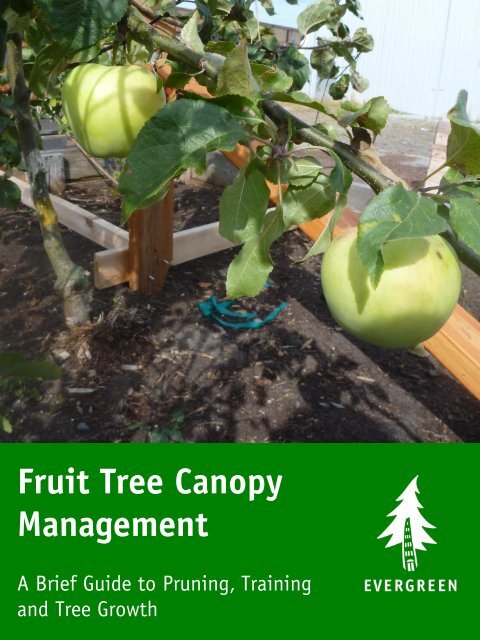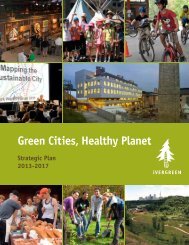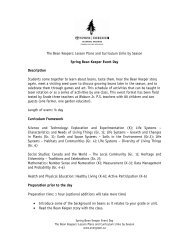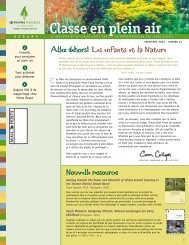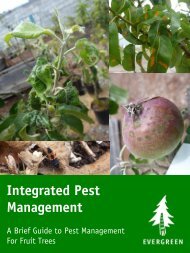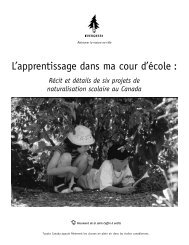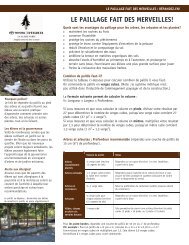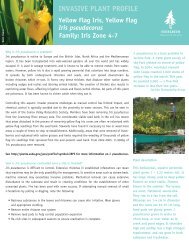Fruit Tree Canopy Management: A Brief Guide to ... - Evergreen
Fruit Tree Canopy Management: A Brief Guide to ... - Evergreen
Fruit Tree Canopy Management: A Brief Guide to ... - Evergreen
You also want an ePaper? Increase the reach of your titles
YUMPU automatically turns print PDFs into web optimized ePapers that Google loves.
<strong>Fruit</strong> <strong>Tree</strong> <strong>Canopy</strong><br />
<strong>Management</strong><br />
A <strong>Brief</strong> <strong>Guide</strong> <strong>to</strong> Pruning, Training<br />
and <strong>Tree</strong> Growth
Introduction<br />
This report is based on a workshop held June 13, 2012 covering the<br />
basics of <strong>Fruit</strong> <strong>Tree</strong> <strong>Canopy</strong> <strong>Management</strong>. This is the fourth in a series<br />
of learning modules covering the basics of fruit tree growing in the<br />
Pacific Northwest. The workshops were hosted by <strong>Evergreen</strong> in<br />
Vancouver, BC; the hands on portions of the workshops are carried out<br />
in <strong>Evergreen</strong>’s mobile urban orchard which consists of 60 dwarf apple<br />
trees.<br />
This workshop was facilitated by Dr. Kent Mullinix, a pomologist who<br />
has worked with fruit trees for the past 35 years. He attended the<br />
University of Missouri where he earned a B.Sc. in Agriculture, M.Sc. in<br />
Horticulture (specializing in Pomology) and Ph.D. in Agriculture<br />
Education (curriculum and program development, crop sciences and<br />
soil conservation). He also earned a Ph.D. from the University of<br />
British Columbia in Plant Science, specializing in integrated pest<br />
management. He is a Professional Agrologist with the British Columbia<br />
Institute of Agrologists and is currently working as the Direc<strong>to</strong>r of<br />
Sustainable Agriculture and Food Security at the Institute for<br />
Sustainable Horticulture, Kwantlen Polytechnic University.<br />
These workshops and learning modules are generously supported by the<br />
Organic Sec<strong>to</strong>r Development Program, Vancity, the Sitka Foundation,<br />
and the Gencon Foundation.<br />
2
Introduction<br />
<strong>Canopy</strong> management is the ‘art’ of fruit<br />
growing - it is much more than cutting off a<br />
few branches. In fact, as you will learn in<br />
this document, removing wood from a tree is<br />
one of the last things you want <strong>to</strong> do. To<br />
optimize your fruit crop, thoughtful canopy<br />
management is one of the most important<br />
subjects <strong>to</strong> master, and the best way <strong>to</strong><br />
master it is through practice!<br />
Why Manage the <strong>Canopy</strong>?<br />
<strong>Fruit</strong> trees produce fruit regardless of human intervention.<br />
<strong>Fruit</strong>s house the seeds needed for trees <strong>to</strong> reproduce –<br />
when birds and animals eat the fruits, they distribute the<br />
seeds <strong>to</strong> start new growth.<br />
However, for human consumption, it is important <strong>to</strong><br />
manage fruit tree canopies <strong>to</strong> optimize the balance<br />
between vegetative growth and fruit production, and also<br />
<strong>to</strong> keep fruit picking manageable. An unmanaged canopy<br />
will grow all its fruit 25 – 30 feet in the air, which is<br />
difficult and just plain dangerous <strong>to</strong> get at!<br />
Managing a canopy will help <strong>to</strong> develop a strong tree that<br />
will support heavy crop loads, while increasing fruit<br />
production and improving fruit quality in the long-term.<br />
3
The Basics<br />
There are three primary methods for managing fruit tree canopies:<br />
Pruning: The removal of limbs or branches from the tree. This is what most of<br />
us think of as canopy management, but it is only one part of a larger process.<br />
Training: Positioning limbs in specific ways <strong>to</strong> manage growth, rather than<br />
removing them. Train rather than prune when possible!<br />
Horticultural Practice: Addition of nutrients, water, etc. E.g. Rather than<br />
cutting limbs, cut back on water and nitrogen <strong>to</strong> s<strong>to</strong>p excessive tree growth.<br />
When do we manage the canopy?<br />
It’s best <strong>to</strong> prune a fruit tree when it is dormant – typically the dormant season<br />
is in the winter months, running from around November <strong>to</strong> early March. Pruning<br />
during the dormant season is ideal for several reasons:<br />
1. You can see the shape and structure of the tree, as there are no leaves –<br />
this gives you a better idea of what you’re working with.<br />
2. The tree’s physiological response <strong>to</strong> pruning will be predictable throughout<br />
the dormant season – whether you prune in November or February, the<br />
tree’s growth response will be the same. The metabolic processes are slow<br />
<strong>to</strong> nonexistent.<br />
3. If you prune during the growing season (spring through fall), it is<br />
impossible <strong>to</strong> know what stage of growth the tree is in, and so it’s growth<br />
response is unpredictable.<br />
4. Microorganisms (e.g. bacterial and fungal infections) are plentiful during<br />
the summer months. Pruning in the summer creates wounds that make<br />
trees more susceptible <strong>to</strong> infections.<br />
4
Growth<br />
Knowledge Toolkit for <strong>Canopy</strong><br />
<strong>Management</strong><br />
Rather than cutting away limbs, we can learn <strong>to</strong><br />
manipulate trees based on our understanding of how<br />
they grow and develop.<br />
As mentioned in our guide on <strong>Fruit</strong> <strong>Tree</strong> <strong>Management</strong>,<br />
all commercially grown fruit trees are made up of two<br />
genetically distinct organisms: a root s<strong>to</strong>ck and a<br />
scion. The roots<strong>to</strong>ck of your tree will affect the way its<br />
canopy grows – a dwarf tree that will only grow <strong>to</strong> 5 ft<br />
must be managed differently than a standard tree that<br />
could grow <strong>to</strong> 25 ft.<br />
The more ‘dwarfing’ a roots<strong>to</strong>ck, the more inclined the<br />
tree will be <strong>to</strong> produce flowers and fruits. Because they<br />
don’t produce as much vegetative (structural) growth,<br />
dwarf trees often need <strong>to</strong> be supported by posts and<br />
trellises.<br />
How do <strong>Tree</strong>s Grow?<br />
<strong>Tree</strong>s have a set amount of energy (created through<br />
pho<strong>to</strong>synthesis) that they can use <strong>to</strong> grow. Based on<br />
external and internal cues, they will produce either<br />
reproductive growth or vegetative growth. <strong>Canopy</strong><br />
management manipulates the allocation of the tree’s<br />
resources <strong>to</strong> favor one kind of growth over another –<br />
creating the right balance is crucial!<br />
Reproductive<br />
Growth: Flowers,<br />
<strong>Fruit</strong>s, Seeds<br />
Vegetative<br />
Growth: Roots,<br />
Shoots, Leaves<br />
5
Growth<br />
Maintaining the Balance<br />
Too much fruit?<br />
We want as much fruit as possible, but <strong>to</strong>o much emphasis on fruit will prevent<br />
good structure. If a tree bears <strong>to</strong>o much fruit <strong>to</strong>o early, it can become ‘runted<br />
out’, or unable <strong>to</strong> grow adequately, and will produce far less fruit in the long run.<br />
It is important that enough vegetative growth occurs in roots, branches, etc. <strong>to</strong><br />
ensure that the tree is healthy and sturdy.<br />
Too much vegetation?<br />
Because one form of growth occurs at the expense of the other, the best way <strong>to</strong><br />
control overly vigorous vegetative growth is <strong>to</strong> let the tree fruit. Pruning can<br />
delay fruiting – if you want more fruit, sooner, don’t prune.<br />
What does good vegetative growth look like? Current season growth should be<br />
between 18 – 20 inches. More than that is excessive and should be controlled.<br />
Less than that will not be enough <strong>to</strong> support fruit.<br />
How should you manage the balance between vegetative and reproductive<br />
growth?<br />
Establishment: When the tree is young, encourage vegetative growth and remove<br />
blossoms <strong>to</strong> prevent fruit growth.<br />
Transition (typically at 3 years): When the tree is approximately the size you<br />
want, begin <strong>to</strong> encourage reproductive growth balanced with vegetative growth.<br />
Mature Bearing <strong>Tree</strong>: When the tree is fully mature and producing fruit,<br />
encourage the fruit and maintain balance.<br />
6
Growth<br />
<strong>Tree</strong>s grow in two ways:<br />
Primary Growth: Growth in length of limbs. This form of growth results from the<br />
activity of the ‘apical meristem’, which creates undifferentiated cells (cells which<br />
have no particular function, but will eventually be differentiated <strong>to</strong> become<br />
blossoms, bark, etc.).<br />
Secondary Growth: Growth outwards and in diameter (i.e. thickening of the limbs).<br />
When managing the canopy, it’s important <strong>to</strong> know what age of wood you’re working<br />
with. This is referred <strong>to</strong> in years, e.g. one year old wood, two year old wood, etc.<br />
Current Season Growth is the new shoot growth expanding from the last terminal<br />
bud. At the end of the season, when the tree goes dormant, it sets up a new<br />
terminal bud at the end of the growth. That growth then becomes one-year-old<br />
wood. Over time you will be able <strong>to</strong> recognize old terminal buds (bud scale scars)<br />
and the age of the wood stemming from them.<br />
Below: The rings of a tree demonstrate<br />
secondary growth. Image: <strong>Tree</strong> Trust<br />
Above: Primary growth over two years<br />
Pho<strong>to</strong>: University of Georgia<br />
7
Growth<br />
<strong>Tree</strong> Habits<br />
Every tree has tendencies <strong>to</strong>wards certain shapes of growth – knowing and<br />
understanding these tendencies can make canopy management much more<br />
efficient.<br />
Growth Habit<br />
The growth habit of a tree is its natural inclination <strong>to</strong>wards a certain canopy<br />
shape. There are two basic growth habits:<br />
Acro<strong>to</strong>nic: Strong growth at the <strong>to</strong>p of<br />
the tree, at the expense of weaker<br />
growth on lower levels. Red Delicious<br />
apple has this tendency.<br />
Basi<strong>to</strong>nic: Lower branches are stronger<br />
and outgrow the <strong>to</strong>p of the tree.<br />
Braeburn apple trees have this tendency.<br />
Above: Acro<strong>to</strong>nic Growth Habit<br />
There are also a number of growth habits<br />
in between, such as columnar or conical<br />
shaped canopies. When managing a<br />
canopy, we generally seek <strong>to</strong> develop a<br />
conical shape where the <strong>to</strong>p of the tree<br />
is narrower than the bot<strong>to</strong>m. This is<br />
easier <strong>to</strong> do with a basi<strong>to</strong>nic growth<br />
habit. Not sure what kind of growth<br />
habit you’re dealing with? Keep an eye<br />
on it as the leaves fall – the structure of<br />
the branches will become apparent.<br />
Above: Basi<strong>to</strong>nic Growth Habit<br />
8
Growth<br />
<strong>Fruit</strong>ing Habit<br />
A tree’s fruiting habit refers <strong>to</strong> the timing of its fruit<br />
production.<br />
Pome <strong>Fruit</strong>s (apple, pear) will only produce fruit on<br />
three year old wood or older. New shoots become year 1<br />
wood. The cells will differentiate in year 2, developing<br />
small spurs which will eventually bear fruit. This wood<br />
overwinters, and blooms in year 3. Good fruit<br />
production will occur on 4 – 5 year old wood, which is<br />
why you want <strong>to</strong> avoid pruning it all off!<br />
S<strong>to</strong>ne <strong>Fruit</strong>s (plum, peach, cherry) produce fruit on two<br />
year old wood. Buds grow in late summer, after the<br />
harvest, rather than in early spring.<br />
Pruning older wood (e.g. 7 years and older) renews a<br />
tree’s fruit production capacity - as wood ages, it<br />
becomes <strong>to</strong>o twisted and vascular for good reproductive<br />
growth.<br />
<strong>Tree</strong>s need sun <strong>to</strong> grow! In addition <strong>to</strong> the sun required <strong>to</strong> fuel the<br />
vegetative growth process:<br />
•<strong>Tree</strong>s require a minimum of 35% illumination throughout the day for flowers<br />
<strong>to</strong> appear.<br />
•Without sun, apples will not develop any color.<br />
•If we let a canopy grow unmanaged, sunlight will not reach lower branches;<br />
fruit will grow on the outside and the <strong>to</strong>p of the trees. To let sunlight filter<br />
through all parts of the canopy, narrow the <strong>to</strong>p of the tree, and thin out the<br />
branches as you work your way in <strong>to</strong> the center. This is one of the only times<br />
where pruning is the best solution!<br />
9
Apical Dominance<br />
The apical meristem, or growing tip, is a<br />
completely undifferentiated tissue found in<br />
the terminal bud of a tree. Its main function<br />
is <strong>to</strong> grow new cells at the tips of roots and<br />
shoots (forming buds, among other things).<br />
An active apical meristem lays down a<br />
growing root or shoot behind itself, pushing<br />
itself forward.<br />
Apical dominance is where the meristem at<br />
the tip of the main trunk prevents or inhibits<br />
the growth of other meristems. This dominant<br />
meristem, which releases the hormone Auxin,<br />
promotes vegetative growth. Therefore, the<br />
tip of the trunk grows rapidly and is not<br />
shadowed by branches. If the dominant<br />
meristem is cut off, one or more other branch<br />
tips will become dominant. These newly<br />
dominant branches will start growing faster<br />
and the new growth will be vertical, leading<br />
<strong>to</strong> bushy growth.<br />
Apical dominance at work<br />
You can train a tree by bringing<br />
shoots/branches down <strong>to</strong> horizontal, altering<br />
the flow of Auxin. The lower you pull the<br />
branch, the more new breaking buds you will<br />
create.<br />
Altering the flow of Auxin<br />
Images: University of Georgia<br />
10
Pruning<br />
All pruning is dwarfing in the sense that<br />
it reduces the overall size of the tree.<br />
Any growth stimulated by cutting is local<br />
and temporary. There are two main kinds<br />
of cuts used in pruning:<br />
Heading: Cutting one year old wood <strong>to</strong><br />
destroy apical dominance and invigorate<br />
local growth. DO NOT go overboard with<br />
heading cuts – you will end up with a<br />
bush.<br />
Heading cuts<br />
Thinning Out: Removing a shoot or shoot<br />
system at the point of origin. These cuts<br />
allow sunshine <strong>to</strong> filter through and<br />
penetrate the tree’s branches. Avoid<br />
cutting everything – often you can find<br />
one or two optimal thinning cuts that<br />
will affect the whole canopy. Thinning<br />
cuts s<strong>to</strong>p or greatly weaken growth – you<br />
are basically telling the branch that it’s<br />
time is done.<br />
A thinning cut 11
Training<br />
When pruning and training trees, there<br />
are a few basic systems <strong>to</strong> choose<br />
between. For more information on each<br />
of these, check out the resources<br />
section at the end of this manual.<br />
Central Leader: For dwarfing trees, it<br />
is common <strong>to</strong> use a Central Leader<br />
System. Weak side shoots are trimmed<br />
back in favor of a central trunk with<br />
side branches.<br />
<strong>Tree</strong> pruned <strong>to</strong> a central leader<br />
Open-Center or ‘Beehive’: In larger<br />
trees we aim for a beehive or A shape<br />
– a slight narrowing at the <strong>to</strong>p and<br />
bot<strong>to</strong>m.<br />
<strong>Tree</strong> pruned with an open center<br />
Espalier: A great method for saving<br />
space when growing dwarf trees –<br />
training limited branches horizontally.<br />
An espaliered tree 12
Tools<br />
<strong>Canopy</strong> management is more about knowledge than it is about equipment– but<br />
there a few critical <strong>to</strong>ols you’ll want <strong>to</strong> have ready when you set <strong>to</strong> work!<br />
Loppers: Find a pair with a bypass blade instead of anvil cutters – this will<br />
ensure that you slice the branch instead of crushing it. A commercial grade pair<br />
such as these ones by Corona are best. They can be purchased at Evergro or Lee<br />
Valley in the BC lower mainland.<br />
Hand Shears: These are good for young trees with low, thinner branches. These<br />
should be made of good steel and should be kept sharp using a wet s<strong>to</strong>ne.<br />
<strong>Tree</strong> Saw: Best for big old trees with branches that are <strong>to</strong>o big for loppers. Most<br />
tree saws cut on the pull.<br />
Ladder: A ladder is the best way <strong>to</strong> get up in<strong>to</strong> a taller tree and see what you’re<br />
doing. It will save you from reaching up and straining yourself, and you’ll make<br />
cleaner cuts as a result. Do NOT use pole pruners <strong>to</strong> try and reach higher<br />
branches – their cuts leave little nubs behind which are essentially little pest<br />
hotels.<br />
13
Resources<br />
This guide can serve as a starting point <strong>to</strong> managing your fruit tree canopy. For<br />
more detail on particular pruning and training styles, the science behind fruit tree<br />
growth, etc., explore some of the resources below.<br />
How <strong>to</strong> Train and Prune Your Home Orchard. Oregon State University Extension<br />
Service: http://extension.oregonstate.edu/gardening/how-train-and-prune-yourhome-orchard<br />
Training and Pruning Apple <strong>Tree</strong>s. University of Wisconsin Extension Services:<br />
http://learnings<strong>to</strong>re.uwex.edu/assets/pdfs/A1959.pdf<br />
Vegetative Growth and Vigor Control. Washing<strong>to</strong>n State University:<br />
http://classes.hortla.wsu.edu/hort310/hort%20310%20-<br />
%20documents/Vegetative%20Growth%20Control.pdf<br />
Pruning <strong>Fruit</strong> <strong>Tree</strong>s Fact Sheet. Ontario Ministry of Agriculture, Food and Rural Areas:<br />
http://www.omafra.gov.on.ca/english/crops/facts/00-005.htm<br />
Training and Pruning Apple <strong>Tree</strong>s. Cornell Cooperation Extension Publication:<br />
http://eap.mcgill.ca/CPTFP_7.htm<br />
Pruning <strong>Fruit</strong> <strong>Tree</strong>s. Nebraska Cooperative Extension:<br />
http://urbanagriculturehub.ca/index.php?doc_action=display&doc_id=213<br />
14


